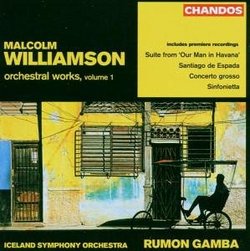Who is Malcolm Williamson?
Russ | Richmond, VA | 08/12/2006
(4 out of 5 stars)
"The Australian born Malcolm Williamson (1931-2003) moved to London around 1950 and became Master of the Queen's music in 1975, holding this distinguished post until his death. This honorary position had been previously occupied by such notable composers as Sir Arthur Bliss, Sir Arnold Bax and Sir Edward Elgar. Although Williamson had studied serialism and championed the organ music of Messiaen, the music on the present release suggests that Williamson was more interested in creating compositions that would be accessible to a broad audience.
It is difficult to get a sense of Williamson's style (if he has one) from just listening to works contained here, as care has been taken to create a varied program of Williamson's works. There are pastoral elements coupled with noble orchestral passages in Santiago de Espada, reminiscent of certain British composers; Finzi perhaps. There are popular elements, tinged with jazz, in the Suite from "Our Man in Havana." The Concerto grosso is a spiky modern work, but is primarily tonal and concludes with a mischievous dance that reaches a satisfying madcap conclusion. The Sinfonietta contains many austere passages but is capped by a rollicking tarantella, which could have been just as easily penned by the other Malcolm (Arnold).
With the incorporation of popular elements, and the composer's tendency to joke around within these compositions, it can be assumed that this music isn't meant to be profound. However, the music held my interest and I found several of the individual movements to be especially engaging as standalone works. The aforementioned tarantella and the Latin-flavored serenade from the "Our Man in Havana" suite are particularly outstanding. Apparently, a conga line formed within the concert hall when the serenade was performed on the last night of the Proms in 1976. The entire suite itself is quite attractive, with several distinctive melodies, which are colored by the addition of maracas and conga drums.
The Satiago de Espada is a charming work. I find it difficult not to smile when I hear the lyrical central theme of this overture mixed combined an alluring descending flute motif. Another interesting piece on this program is the Sinfonietta's toccata which alternates between an angular Prokofiev-like marching theme and a lovely flowing passage scored for strings.
So at the very least I can say this music is interesting, as well as fun, and leaves me wondering what the other compositions of Williamson hold, especially the seven symphonies. With that said, I don't think any of the compositions here are masterpieces. However, Williamson appears to be a talented composer who understood the importance of connecting with his audience.
Recommended.
57:13"

